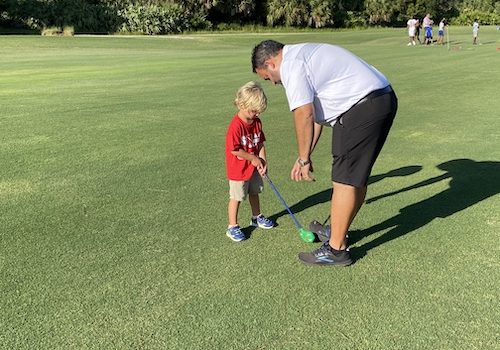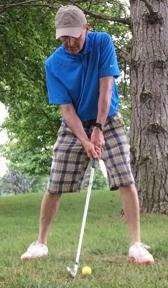
How to Achieve Good Golf Posture
Many people consider grip to be one of the most crucial facets of golf performance. While grip can be essential to swing angle and ball direction, posture is more important to the overall game.
Posture is one of the most critical factors to golf performance. Not only can posture be vital for making the perfect swing, but it can also keep a golfer up and running for longer. IRGF has great tips and tricks on how to achieve proper golf posture.
What Is Good Posture?
Professional golfers usually recommend that a player stands upright, with arms and legs straight. This type of good posture can ensure the player hits the ball at the best angle while remaining healthy. Proper posture in general keeps your body fit and in shape, but proper golf posture can actually improve your game!
Overall, the following steps indicate good golf posture:
1. Straighten your legs and back.
2. Hold the club out in front of you.
3. Bend your back, keeping it straight.
4. Lower the club straight down. Do not bend your arms.
5. Slightly bend your knees as you prepare to hit the ball.
6. Lift your head, pushing back your shoulders as you hit the ball.
7. Hit the ball, keeping your back straight as you swing.
These steps may seem unnatural or complex, but they get more natural over time. Many players struggle to correct their posture first, but once they learn, golf becomes easier for them.
Good posture can keep a player playing golf for longer, preventing issues such as back pain or muscle pulls. Also, good posture can help keep a player’s eye on the ball, allowing them to make the perfect swing every time.
Why Good Posture is So Important
If a player naturally slumps when they hit a ball, this pattern can be a difficult one to break. It might feel unnatural to stand up perfectly straight, but doing so can ensure that muscles and bones stay strong and healthy.
A slumping posture can result in future back issues, all while making it harder to get the perfect angle when swinging.
Players that practice good golf posture have a straight back and legs and slightly bent knees. If the back is tilted too much, it can result in potential back issues later down the line. It can also reduce aim accuracy and potentially strain back muscles.
Knees that are bent too much can result in soreness or pain in the legs and knees. To prevent this, be sure to correct poor leg posture before hitting the ball.
What is Posture Loss?
Poor posture can eventually lead to posture loss, which can harm a player’s performance.
Posture loss is a gradual degradation of a golfer’s posture until it is no longer correct at all. Also, posture loss can impact muscle health, golf performance, and flexibility. If a golfer is gradually starting to slump, an instructor or teacher should correct their posture.
How to Correct Posture Loss
With proper coaching, a golfer can get back on track and correct their posture. To return to their good posture habits, a golfer should practice the golf stance before playing.
To do this, we recommend:
- Having a coach or friend check your posture before you hit the ball
- Practicing posture at home or before you practice
- Watching the way professionals hit the ball before practicing
- Making an effort to correct pressure if you begin to fall back into bad posture habits
Eventually, a golfer can fix their posture, which will significantly benefit their game. Golfing can be stressful on the body over time, so having proper posture can prevent any potential difficulties or complications.
It can also keep players on the green for longer, resulting in better performance and a more enjoyable time.
Good Posture Can Lead to Consistent Performance
If a player is struggling to perform consistently, it could be an indicator of issues with posture. Seemingly random golf performance could be a sign that a player’s stance is off or inconsistent. Having a steady, stable posture can make a player more naturally consistent.
Consistency occurs because a golfer has gotten used to the angle the ball will go. By placing their arms, legs, and back in the same positions every time they hit, a golfer allows their body to get used to the motions of hitting.
Once the body has acclimated to these positions, it will be much easier to anticipate where the ball will go and how hard a player needs to hit it.
Consistent performance can help players develop a strategy when they get to the course. By knowing how the body reacts to golf posture, a player is preparing themselves for better performance. Once a player does this, they are setting themselves up for success on the field.
Proper Golf Posture Provides Stability
Stability is vital in the game of golf. It allows golfers to hit the ball with plenty of force, letting it go as far as possible. Balance is the force players need to succeed when first starting on a hole. It can also help players to focus on short chips or putts into the hole.
Stability relies on the consistency that proper golf posture gives a player. By knowing what force to hit the ball at, the player knows how hard they will hit the ball, even before they hit it. This strategy allows players to change how they hit the ball in various situations, giving them a full range of performance.
Stability is a great way to improve overall golf performance. Posture provides the perfect foundation for this stability, which is why so many coaches and teachers focus on posture with their students.
Keep Practicing!
If you struggle with posture, don’t worry! Players can quickly correct it through practice and posture drills. Have a coach, friend, or instructor guide you through the best ways to improve your golf posture.
With dedication and lots of practice, you’ll be on your way to a better game of golf in no time!
Learn More With Indian River Golf Foundation
If you’re excited to get on the course and perfect your posture, contact the Indian River Golf Foundation. We would love to help you tee up!
If you have any questions about our organization or any of our programs, feel free to reach out at (772) 713-9593 or reach out via email.




This Post Has 0 Comments